学术论文写作分析解析
谈学术论文写作(一):选题、标题及绪论

谈学术论文写作(一):选题、标题及绪论作者:吴克明题记:各位研究生,上一篇《谈研究生阅读:目标、价值和方法》谈的是阅读方面的问题,这一次谈谈论文写作方面的问题,与大家分享。
祝愿大家学业进步!一篇高质量学术论文的标准包括:选题有价值、观点新颖、内容充实、论据充分、论证得当、逻辑自洽、研究方法科学、结构完整、层次分明、语言表达准确流畅、言简意赅,符合论文写作规范。
本文主要从论文选题、题目、绪论、本论、结论、结构、构段、摘要、表达等九个方面探讨学术论文的写作方法。
一、论文的选题好的选题等于成功的一大半。
一些写作者开始不知道研究什么问题,感到无题可写,不知写什么好。
那么,选题来自哪里呢?对于有两个重要的来源,一是来源于实践。
一是来源于理论。
对于研究生来说,更适宜于从社会现象中选题。
俗话说,处处留心皆学问。
来源于实践的选题,要求我们平时留心观察社会发生的现象、出现的问题,这些问题既可以是身边发生的,也可以是媒体报道的,当然这些问题应该是与自己的知识基础、专业背景相一致。
所选择的问题应该是能够用一定的理论来解释,为此,要求我们平时应该多读书、积累扎实的理论功底,尽可能的掌握多一些理论。
在这个意义上,搞好科研论文写作,有大量的功夫在写作之外。
“工夫在诗外”。
掌握的理论知识越丰富、越深刻,那么分析问题的角度就越多、论证的力度就越强,论文写作的质量就越高。
所以大家在一两年的学习期间,一定要认真的精读几本名著,作为论文写作的分析武器。
如何选择一个好题?应该遵循以下几个原则:第一,意义性原则。
选题要有一定的实践意义或理论意义。
实践意义是指该选题总是针对一定的现实问题,研究该选题有利于解决一定的现实问题。
比如,当前企业人才流失问题,比如员工工作积极性不高等。
宽泛的讲,任何论文选题都应该具有现实意义,尤其是对工作在管理、生产实践第一线的工作者而言,直接接触到大量的现实问题,更容易发现实践问题,所以选题应该来说,容易做到这一点。
学术写作全解析

学术写作全解析学术写作是指在学术领域中进行文献研究和学术论述的一种写作方式。
它要求作者具备一定的学术素养和写作技巧,能够准确、系统地表达研究成果、论点和观点,以便于其他学者进行理解和讨论。
本文将从学术写作的特点、结构和语言运用等方面进行全面解析。
一、学术写作的特点学术写作有其独特的特点,主要包括以下几点。
1.客观性:学术写作注重客观性,要求作者在表达观点时要基于事实和证据,并避免主观个人色彩的干扰。
因此,学术写作中常用的语气是客观中性的。
2.准确性:学术写作强调准确性,要求作者精确描述研究对象、方法以及结果等内容,并避免使用模糊或歧义的表达。
在表达上,可通过提供数据、引用文献等方式来支持所提出的观点。
3.逻辑性:学术写作要求作者有清晰的逻辑思维能力,能够将观点有条理地组织起来,使读者能够清晰地理解论文的结构和内容。
在组织结构上,常采用“引言-方法-结果-讨论-结论”的逻辑框架。
4.可验证性:学术写作的观点和结论需要具备可验证性,即其他研究者可以通过实证研究来验证或推翻。
为了增加可验证性,学术写作中常使用引用文献的方式,引用他人研究结果作为支持或参考。
二、学术写作的结构学术写作的结构是指文稿的组织方式和章节划分。
一般情况下,学术写作采用以下结构。
1.引言:引言部分是整篇文章的开头,用于介绍研究的背景、目的和意义,引入读者对该研究问题的认识和理解。
2.方法:方法部分是对研究方法和实验设计进行详细描述的部分。
作者需要清晰地描述实验材料、实验步骤、数据处理等内容,以便于读者能够重复实验。
3.结果:结果部分是对实验或研究结果的呈现和分析,通常采用文字、图表和统计数据的形式展示研究结果。
在结果的解释中,作者需要简洁明了地解读实验数据,讲清楚结果和目标之间的关系。
4.讨论:讨论部分是对结果进行解读、分析和论述的部分。
作者需要对实验结果进行比较、分析,与已有研究进行对比和讨论,提出自己的观点,并说明实验结果对于学术界和实际应用的意义。
研究生论文写作中的常见问题解析

研究生论文写作中的常见问题解析研究生论文是研究生阶段必须完成的重要学术任务,对于学生来说,写作过程中常常会遇到一些问题。
本文将对研究生论文写作中的常见问题进行解析,并提供解决方法,以帮助研究生顺利完成论文。
一、选题问题选题是研究生论文写作的第一步,合适的选题是论文成功的关键。
但是,研究生在选题时常常存在以下问题:1.过于宽泛或过于狭窄的选题范围。
选题太宽泛会导致研究难度过大,选题太狭窄又会限制研究的深度。
解决方法:在选题时要注意找到适中的范围。
可以从具体的研究领域出发,结合自己的兴趣和实际情况,选择一个既有挑战性又可行的课题。
2.选题缺乏创新性。
研究生阶段应该具有一定的创新性,但有些学生在选题时只是沿袭已有研究,缺乏新意。
解决方法:在选题时要积极寻找前人研究的不足之处,找到可以改进或深入研究的方向,以提出新的观点或解决方案。
二、文献综述问题在写研究生论文时,文献综述是必不可少的一部分。
然而,学生在进行文献综述时往往会遇到以下问题:1.文献综述过于琐碎或过于简单。
有些学生在综述文献时只是简单罗列前人的研究成果,没有对其进行深入的分析和总结。
解决方法:在文献综述时要注意对各个研究的关键内容进行梳理和比较,分析其优缺点,归纳出可以借鉴的思路或方法。
2.引用不规范。
有些学生在文献综述中存在引用不规范、未注明出处等问题,这会对论文的学术性造成负面影响。
解决方法:学生应该学习和掌握科学的引用规范,如何正确引用他人的研究成果,并在论文中注明出处。
可以参考学术期刊的格式要求和规范。
三、写作和结构问题研究生论文写作中的写作和结构问题是学生普遍面临的挑战。
以下是一些常见问题及解决方法:1.语言表达不准确或有歧义。
学生在写作过程中,可能会存在表达不清晰、用词不准确或出现语法错误等问题。
解决方法:学生可以通过多读优秀的论文和参考资料,提高自己的语言表达能力。
同时,可以请教导师或请专业的编辑进行修订和修改。
2.逻辑结构混乱或缺乏层次感。
音乐学研究论文写作解析音乐艺术与创作技巧
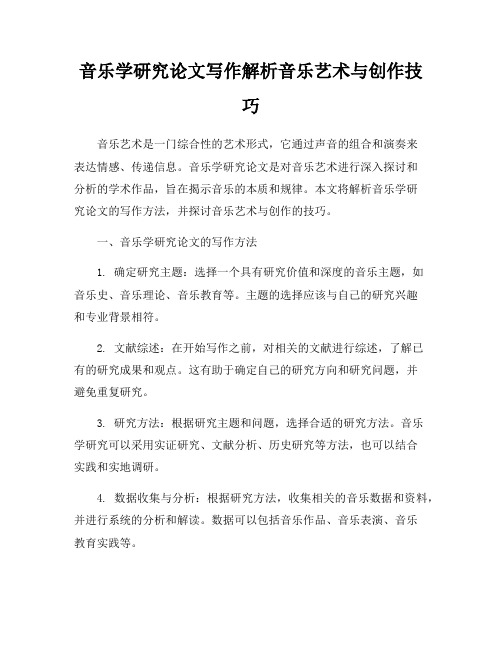
音乐学研究论文写作解析音乐艺术与创作技巧音乐艺术是一门综合性的艺术形式,它通过声音的组合和演奏来表达情感、传递信息。
音乐学研究论文是对音乐艺术进行深入探讨和分析的学术作品,旨在揭示音乐的本质和规律。
本文将解析音乐学研究论文的写作方法,并探讨音乐艺术与创作的技巧。
一、音乐学研究论文的写作方法1. 确定研究主题:选择一个具有研究价值和深度的音乐主题,如音乐史、音乐理论、音乐教育等。
主题的选择应该与自己的研究兴趣和专业背景相符。
2. 文献综述:在开始写作之前,对相关的文献进行综述,了解已有的研究成果和观点。
这有助于确定自己的研究方向和研究问题,并避免重复研究。
3. 研究方法:根据研究主题和问题,选择合适的研究方法。
音乐学研究可以采用实证研究、文献分析、历史研究等方法,也可以结合实践和实地调研。
4. 数据收集与分析:根据研究方法,收集相关的音乐数据和资料,并进行系统的分析和解读。
数据可以包括音乐作品、音乐表演、音乐教育实践等。
5. 论文结构:音乐学研究论文一般包括引言、文献综述、研究方法、数据分析、结论等部分。
在写作过程中,要注意逻辑清晰、层次分明,确保论文的整体结构和内容的连贯性。
二、音乐艺术与创作技巧1. 音乐表达:音乐艺术的核心是表达情感和思想。
在创作音乐时,要注重情感的表达,通过音乐的旋律、节奏、和声等元素来传递情感和思想。
2. 创新与传统:音乐创作既要保持对传统的尊重和继承,又要有创新的思维和实践。
可以借鉴传统的音乐形式和技巧,同时加入自己的创新元素,使作品更具个性和独特性。
3. 音乐结构:音乐作品的结构是其组织和发展的基础。
在创作过程中,要注意音乐的整体结构和内部的逻辑关系,使作品具有完整性和连贯性。
4. 音乐技巧:音乐创作需要掌握一定的音乐技巧,如和声、编曲、演奏等。
通过学习和实践,不断提高自己的音乐技巧,才能更好地表达自己的音乐创作意图。
5. 音乐欣赏与批评:音乐艺术的创作和欣赏是相互促进的。
学术论文写作中的文献引用及引用分析技巧
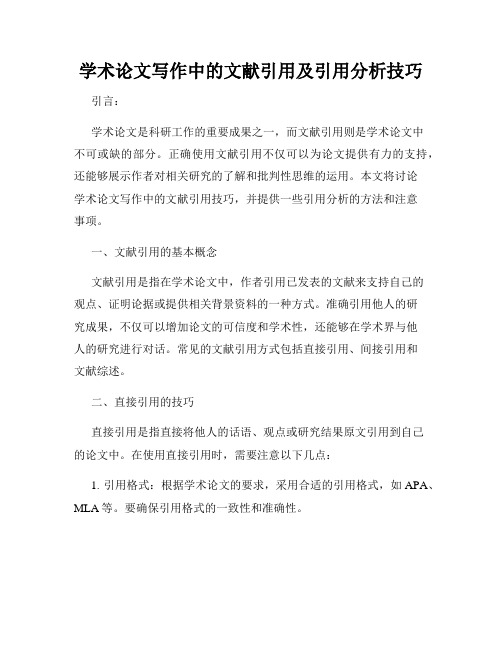
学术论文写作中的文献引用及引用分析技巧引言:学术论文是科研工作的重要成果之一,而文献引用则是学术论文中不可或缺的部分。
正确使用文献引用不仅可以为论文提供有力的支持,还能够展示作者对相关研究的了解和批判性思维的运用。
本文将讨论学术论文写作中的文献引用技巧,并提供一些引用分析的方法和注意事项。
一、文献引用的基本概念文献引用是指在学术论文中,作者引用已发表的文献来支持自己的观点、证明论据或提供相关背景资料的一种方式。
准确引用他人的研究成果,不仅可以增加论文的可信度和学术性,还能够在学术界与他人的研究进行对话。
常见的文献引用方式包括直接引用、间接引用和文献综述。
二、直接引用的技巧直接引用是指直接将他人的话语、观点或研究结果原文引用到自己的论文中。
在使用直接引用时,需要注意以下几点:1. 引用格式:根据学术论文的要求,采用合适的引用格式,如APA、MLA等。
要确保引用格式的一致性和准确性。
2. 引号使用:直接引用的部分需要用引号括起来,并注明引用者的姓名、出处和引文页码。
例如,“某某作者在其研究中指出:‘……’”(引用者, 年份, p.页码)。
3. 文献标注:在正文中的引用部分后面,要给出完整的文献标注,以便读者可以找到原文。
标注格式应符合所采用的引用格式规范。
三、间接引用的技巧间接引用是指作者通过自己的言辞对他人观点或研究结果进行解释和概括,而非直接引用原文。
在使用间接引用时,需要注意以下几点:1. 准确表达:通过间接引用,要确保准确表达出他人的观点或研究成果,并尽可能使用自己的语言进行解释。
2. 引用标注:在间接引用的部分后面,仍然需要给出文献标注,以确保读者可以找到原文的出处。
四、文献综述的技巧文献综述是一种常见的文献引用方式,在论文的相关背景介绍和研究现状分析中广泛运用。
在进行文献综述时,需要注意以下几点:1. 选择合适的文献:根据研究的主题和目的,选择与研究内容相关且有代表性的文献进行综述。
2. 组织结构清晰:在文献综述部分,按照时间、主题或方法等合适的顺序组织文献,使读者能够清晰地了解研究领域的发展和现状。
学术论文的结构和段落划分技巧解析
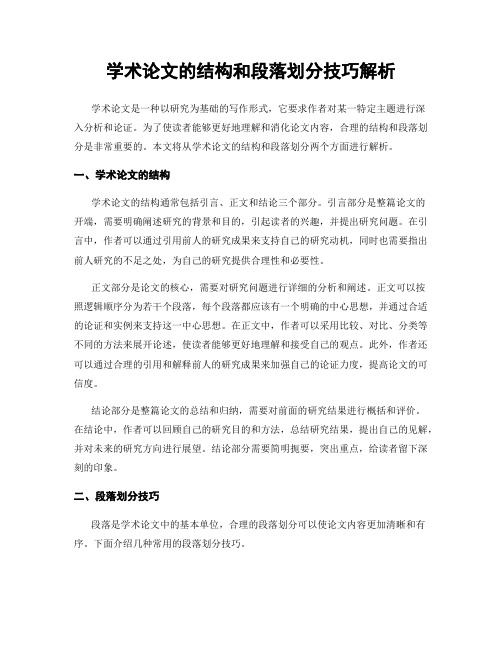
学术论文的结构和段落划分技巧解析学术论文是一种以研究为基础的写作形式,它要求作者对某一特定主题进行深入分析和论证。
为了使读者能够更好地理解和消化论文内容,合理的结构和段落划分是非常重要的。
本文将从学术论文的结构和段落划分两个方面进行解析。
一、学术论文的结构学术论文的结构通常包括引言、正文和结论三个部分。
引言部分是整篇论文的开端,需要明确阐述研究的背景和目的,引起读者的兴趣,并提出研究问题。
在引言中,作者可以通过引用前人的研究成果来支持自己的研究动机,同时也需要指出前人研究的不足之处,为自己的研究提供合理性和必要性。
正文部分是论文的核心,需要对研究问题进行详细的分析和阐述。
正文可以按照逻辑顺序分为若干个段落,每个段落都应该有一个明确的中心思想,并通过合适的论证和实例来支持这一中心思想。
在正文中,作者可以采用比较、对比、分类等不同的方法来展开论述,使读者能够更好地理解和接受自己的观点。
此外,作者还可以通过合理的引用和解释前人的研究成果来加强自己的论证力度,提高论文的可信度。
结论部分是整篇论文的总结和归纳,需要对前面的研究结果进行概括和评价。
在结论中,作者可以回顾自己的研究目的和方法,总结研究结果,提出自己的见解,并对未来的研究方向进行展望。
结论部分需要简明扼要,突出重点,给读者留下深刻的印象。
二、段落划分技巧段落是学术论文中的基本单位,合理的段落划分可以使论文内容更加清晰和有序。
下面介绍几种常用的段落划分技巧。
1. 主题句法:每个段落的第一句话通常是主题句,它用来概括和引导整个段落的内容。
主题句应该简明扼要,能够准确地表达段落的中心思想,引导读者进入下一段的内容。
2. 逻辑顺序:段落中的句子应该按照逻辑顺序进行组织,确保句子之间的关系清晰明了。
可以使用时间顺序、空间顺序、因果关系等不同的逻辑顺序来组织段落,使读者能够更好地理解和接受作者的观点。
3. 连贯性:段落中的句子之间应该具有一定的连贯性,通过合适的过渡词和连接词来实现。
学术论文写作思路

学术论文写作思路学术论文是一种专业性较强的写作形式,旨在对某个研究领域的问题进行深入分析、论证和探讨。
在撰写学术论文时,作者应该遵循一定的思路和方法,以确保文章内容准确、有条理、具备学术价值。
本文将为您介绍一些关于学术论文写作的思路和技巧。
一、明确研究问题学术论文的第一步是明确研究问题。
作者应该选择有足够研究价值和现实意义的问题,并对该问题进行准确的界定。
在明确研究问题的过程中,可以参考相关的文献、调查研究和专家意见,以确保自己对问题有准确的理解。
二、文献综述文献综述是学术论文中不可或缺的一部分,它可以帮助读者了解到该领域的研究现状、关键问题和争议点。
在写作文献综述时,作者应该广泛阅读相关文献,并将其进行整理和分析。
通过对先前研究的综合梳理,可以对研究问题的背景和理论基础有更深入的认识。
三、研究方法在学术论文中,研究方法是非常重要的一部分。
选择合适的研究方法可以帮助作者收集和分析数据,对问题进行客观的评估。
常用的研究方法包括实证研究、案例研究、问卷调查等。
作者应该根据研究问题的性质和实际情况选择最适合的研究方法,并详细描述研究方法的步骤和操作流程。
四、实证研究与数据分析实证研究是学术论文的核心部分,它包括数据的收集、整理、分析和解释。
作者应该清晰地描述研究过程中所采用的数据来源、样本选择和数据处理方法。
在数据分析过程中,可以使用统计分析软件进行数据处理和结果呈现。
同时,作者还应该对数据结果进行详细的解读和分析,以支持自己的研究假设或结论。
五、结论与展望学术论文的结论部分应该对研究问题做出总结,并给出具体的结论和建议。
结论部分要简明扼要,言之有物,不要出现与研究问题无关的内容。
此外,作者还可以在结论部分对研究的局限性进行评述,并提出进一步研究的展望。
六、参考文献在学术论文的最后,作者需要列出自己在写作过程中引用的参考文献。
参考文献应该按照一定的格式要求进行排版,并确保引用格式的准确性和规范性。
一般来说,学术论文的参考文献可以采用APA、MLA等标准引用格式。
医学论文的撰写与常见问题解析大全

医学论文的撰写与常见问题解析大全近年来,随着中医药学科研事业的快速发展,每年都有大量的中医药科研论文发表,但仔细阅读不难发现有各种各样的问题。
如写作层次不清,表达凌乱,不能有条理地清楚地把自己的观点和研究结果表达出来;有的研究方法不当,设计不合理,统计方法错误等,都影响了中医药科技论文的质量。
为此,下面就医学论文的特点、主要体裁、习惯写法以及在写作方法方面经常出现的问题做一简单介绍。
1 医学论文的特点医学学术论文是论证性文章,要求有鲜明的论点、充分的论据、正确的论证方法,论点、论据和论证是其三大要素。
科学性、创新性、学术性、规范性、可读性是医学论文的特点。
1.1 科学性医学论文的生命力在于它的科学性。
所谓“科学性”,表现在真实性、全面性和逻辑性3个方面。
要求从选题、设计、观察研究到推理和结论,每一步都要有严肃的态度、严格的要求和严密的方法;选题要有足够的科学依据,设计要有充分的可靠性、可比性和必要的随机性,观察研究要真实、准确和全面;要强调推理的逻辑性和结论的严谨性。
没有科学性的“论文”不但毫无价值,而且还可能把别人引入歧途,造成有害结果。
1.2 创新性医学论文的灵魂在于它的创新性。
所谓“创新”是指前人没有做过或没有发表过的科研成果,是指从新的角度阐明新的问题,如在基础研究方面,有新发现、新观点;在临床研究方面,观察更深,诊断方法有创新,治疗效果更好,或古方新用,提出新见解等。
1.3 学术性学术性主要表现在专业性上,医学是专业性很强的知识,应区别于科普性的一般知识。
同时,医学又是一门应用科学,指导作用越强,越受读者的欢迎。
1.4 规范性规范性是医学论文在表现形式上的重要特点,是要求论文的书写形式符合约定俗成的相对固定的程式。
这种规范化的程式,是无数科学家写作经验的科学总结,具有很强的生命力。
1.5 可读性要求文字表达准确、简练、通顺,使读者以最少的精力获得最多的知识和信息。
此外,可读性还包含这样两层意思:一是让读者看得懂,即对该专业内学者来说它是易读的,对非专业读者来说它是可以理解的,切忌模糊晦涩;二是让读者乐意看,有一定的生动性,切忌干瘪乏味。
论文写作中的引文分析和学术网络
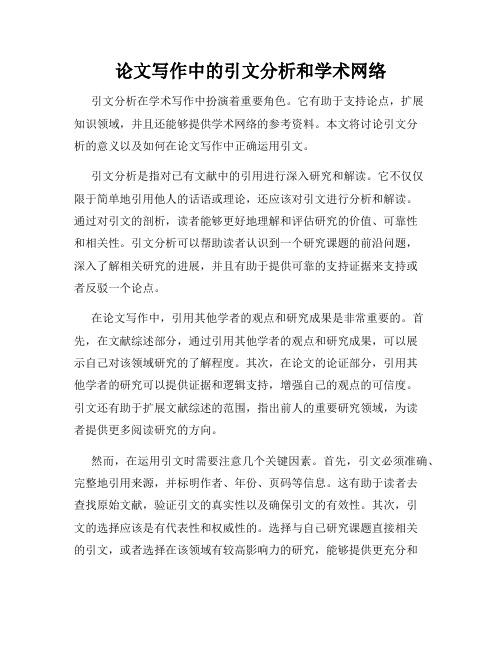
论文写作中的引文分析和学术网络引文分析在学术写作中扮演着重要角色。
它有助于支持论点,扩展知识领域,并且还能够提供学术网络的参考资料。
本文将讨论引文分析的意义以及如何在论文写作中正确运用引文。
引文分析是指对已有文献中的引用进行深入研究和解读。
它不仅仅限于简单地引用他人的话语或理论,还应该对引文进行分析和解读。
通过对引文的剖析,读者能够更好地理解和评估研究的价值、可靠性和相关性。
引文分析可以帮助读者认识到一个研究课题的前沿问题,深入了解相关研究的进展,并且有助于提供可靠的支持证据来支持或者反驳一个论点。
在论文写作中,引用其他学者的观点和研究成果是非常重要的。
首先,在文献综述部分,通过引用其他学者的观点和研究成果,可以展示自己对该领域研究的了解程度。
其次,在论文的论证部分,引用其他学者的研究可以提供证据和逻辑支持,增强自己的观点的可信度。
引文还有助于扩展文献综述的范围,指出前人的重要研究领域,为读者提供更多阅读研究的方向。
然而,在运用引文时需要注意几个关键因素。
首先,引文必须准确、完整地引用来源,并标明作者、年份、页码等信息。
这有助于读者去查找原始文献,验证引文的真实性以及确保引文的有效性。
其次,引文的选择应该是有代表性和权威性的。
选择与自己研究课题直接相关的引文,或者选择在该领域有较高影响力的研究,能够提供更充分和可信的证据。
最后,在引文分析时需要对引文进行解读、评估和比较,突出引文在当前研究领域中的重要性和价值。
学术网络是一个由学者、机构和文献组成的庞大网络。
引文是学术网络的一种重要连结,通过引用其他学者的观点和研究成果,学术网络能够形成复杂的知识体系。
学术网络的建立和发展需要学者们共同努力,通过引用和被引用,不断扩大学术圈子和学术影响力。
在网络中,学者们通过相互引用和相互交流,使自己的研究成果得到广泛传播和认可。
在学术网络中,引文的使用也存在一些争议和问题。
一方面,过度引用他人的观点可能导致学术剽窃和知识的单一化。
研究生论文写作中的论点建构与分析

研究生论文写作中的论点建构与分析研究生论文是研究生阶段的重要学术成果之一,论文的质量往往取决于论点的建构和分析。
有效的论点能够引导整篇论文的推导和阐述,因此,合理构建和深入分析论点是研究生论文写作中的关键步骤。
本文将探讨论点的定义、建构和分析方法,旨在帮助研究生更好地写作和提升论文质量。
一、论点的定义论点是论文的核心主张,也是作者对研究问题的解答或者立场的表达。
论点应当具备以下几个特点:明确、具体、可辩证、有说服力。
1. 明确:论点要清晰明了地表达出来,让读者一目了然,避免模糊和含糊不清的表述。
2. 具体:论点应具备具体性,不应过于笼统或泛泛而谈。
具体的论点更有说服力,并能更好地指导论文的写作。
3. 可辩证:好的论点应当具备可辩证性,能够充分考虑问题的各个方面,避免过于片面或偏颇的立场。
4. 说服力:论点应当有一定的说服力,通过合理的论证和可靠的证据来支持,使读者对该论点产生共鸣和认同。
二、论点的建构论点的建构是研究生论文写作的首要任务,其中包括选择合适的论题、明确研究目标以及构建合理的论点。
1. 选择论题:选择适合研究生论文的论题非常重要。
合适的论题应当具备学术性、前瞻性和研究价值,能够激发读者的兴趣,并为研究生的学术成长提供有益的探索空间。
2. 明确研究目标:明确研究目标是建构论点的基础。
研究生应当明确自己的研究目标,从中找到研究问题,并为问题提供解答。
3. 构建合理的论点:基于研究目标,研究生应当构建出合理的论点。
论点应当能够回答研究问题,并提供充足的理由和证据来支持自己的观点。
三、论点的分析论点的分析是研究生论文写作过程中的重要环节,通过分析论点,可以更好地展现出自己的思考深度和学术能力。
1. 论点解析:首先要对论点进行解析,弄清楚论点的核心思想是什么,表达的立场是什么,并明确其在整篇论文中的地位和作用。
2. 论点论证:论点论证是分析论点的核心环节,需要提供充足的理由和证据来支持论点的正确性和可信度。
论文写作中的讨论与解释
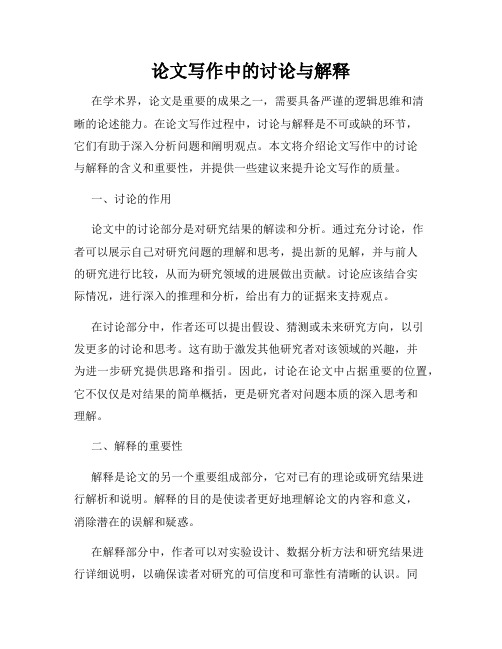
论文写作中的讨论与解释在学术界,论文是重要的成果之一,需要具备严谨的逻辑思维和清晰的论述能力。
在论文写作过程中,讨论与解释是不可或缺的环节,它们有助于深入分析问题和阐明观点。
本文将介绍论文写作中的讨论与解释的含义和重要性,并提供一些建议来提升论文写作的质量。
一、讨论的作用论文中的讨论部分是对研究结果的解读和分析。
通过充分讨论,作者可以展示自己对研究问题的理解和思考,提出新的见解,并与前人的研究进行比较,从而为研究领域的进展做出贡献。
讨论应该结合实际情况,进行深入的推理和分析,给出有力的证据来支持观点。
在讨论部分中,作者还可以提出假设、猜测或未来研究方向,以引发更多的讨论和思考。
这有助于激发其他研究者对该领域的兴趣,并为进一步研究提供思路和指引。
因此,讨论在论文中占据重要的位置,它不仅仅是对结果的简单概括,更是研究者对问题本质的深入思考和理解。
二、解释的重要性解释是论文的另一个重要组成部分,它对已有的理论或研究结果进行解析和说明。
解释的目的是使读者更好地理解论文的内容和意义,消除潜在的误解和疑惑。
在解释部分中,作者可以对实验设计、数据分析方法和研究结果进行详细说明,以确保读者对研究的可信度和可靠性有清晰的认识。
同时,作者还可以解释一些研究中的限制和局限性,避免读者对研究结果的过度解读。
解释应该以客观、准确的方式进行,确保读者对论文内容的理解与作者的意图保持一致。
另外,解释还可以对研究结果的意义和实际应用进行阐述。
作者可以指出研究结果对相关领域的贡献,以及对理论、实践或政策的影响。
这有助于读者更好地理解研究的实际意义和社会价值,为将来的研究和实践提供借鉴和参考。
三、论文写作中的讨论与解释技巧1. 逻辑严密:在讨论和解释时,应注意逻辑推理的严谨性。
论点应该有明确的前提,并与论文中的证据相符合。
避免出现无中生有或过度解读的情况。
2. 结合实际:讨论和解释应该结合实际情况,尽可能使用具体的案例、数据或实例来支持观点。
如何进行毕业论文的理论分析与解释
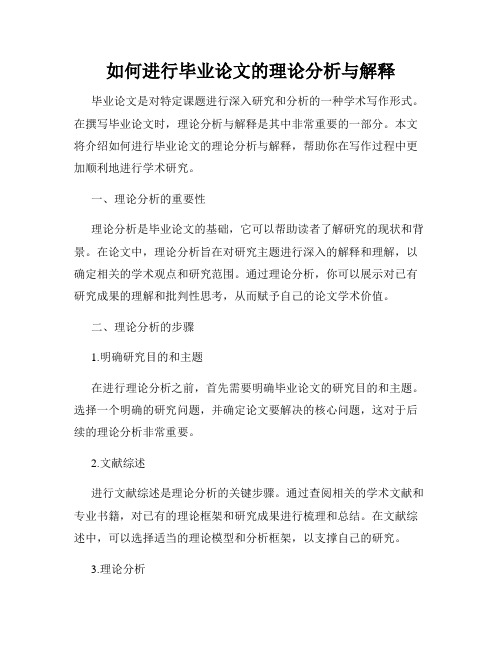
如何进行毕业论文的理论分析与解释毕业论文是对特定课题进行深入研究和分析的一种学术写作形式。
在撰写毕业论文时,理论分析与解释是其中非常重要的一部分。
本文将介绍如何进行毕业论文的理论分析与解释,帮助你在写作过程中更加顺利地进行学术研究。
一、理论分析的重要性理论分析是毕业论文的基础,它可以帮助读者了解研究的现状和背景。
在论文中,理论分析旨在对研究主题进行深入的解释和理解,以确定相关的学术观点和研究范围。
通过理论分析,你可以展示对已有研究成果的理解和批判性思考,从而赋予自己的论文学术价值。
二、理论分析的步骤1.明确研究目的和主题在进行理论分析之前,首先需要明确毕业论文的研究目的和主题。
选择一个明确的研究问题,并确定论文要解决的核心问题,这对于后续的理论分析非常重要。
2.文献综述进行文献综述是理论分析的关键步骤。
通过查阅相关的学术文献和专业书籍,对已有的理论框架和研究成果进行梳理和总结。
在文献综述中,可以选择适当的理论模型和分析框架,以支撑自己的研究。
3.理论分析在理论分析阶段,需要结合前期的文献综述,深入分析研究问题,并运用相关的理论模型和概念进行解释。
可以从不同的角度出发,探索研究问题的多个维度,以确保论文的理论分析充分准确。
4.举例和论证为了更好地展示理论分析的可行性和准确性,可以借用实际案例或者数据进行举例和论证。
通过将理论与实际应用相结合,可以更好地使读者理解和接受所提出的研究观点和分析结论。
三、理论解释的重要性理论解释是对前期理论分析结果进行解释和说明的过程。
在论文中,理论解释是将理论与实际案例相结合,以达到更好的论证效果。
理论解释能够进一步澄清和说明研究观点,强调研究的学术价值和现实意义。
四、理论解释的步骤1.对理论分析结果进行归纳和总结在理论解释之前,需要对理论分析的结果进行归纳和总结。
将前期的理论分析转化为简洁明了的观点,以便于更好地进行解释和说明。
2.运用实际案例进行解释通过选择适当的实际案例,可以将理论分析与实际应用相结合进行解释。
17.学术论文的文章结构分析以及写作要求简介

首都师范大学图书馆百分讲座
论文组成部分
论文题名(中英文) 作者姓名+通讯地址(中英文) 摘要+关键词(中英文)
前臵结构
引言(Introduction) 材料与方法(Materials and methods) 结果(Results) 讨论(Discussion)/结论(Conclusion) 主体结构 致谢 参考文献
简短确切的题名,连同图号臵于图下
首都师范大学图书馆百分讲座
常用摘要的类型
名称
报道性 摘要
指示性 摘要
目的
内容
适用
可以部分地取 全面、简要地概括论 研究论文 代阅读全文 文的目的、方法、主 要数据和结论。
可用于帮助潜 在的读者来决 定是否需要阅 读全文。 一般只用二三句话叙 述撰写目的,概括论 文主题,而不涉及论 据和结论。 基础学科的 论文、管理 论文、专题 论述、综述 等
1. 真实姓名,不用笔名。 2. 如果第一作者不是通讯作者, 作者应按期刊的相关规定 表达。期刊多以星号(*)、脚注或致谢的形式标注通 讯作者。
首都师范大学图书馆百分讲座 通常执笔者排在首位,名之间用逗号 “,”;不同工作单位的作者,应在姓 名右上角加注不同的阿拉伯数字序号
单位名称与省市名之间应以逗号“,”;其工作单位名称 之前加与作者姓名序号相同的数字;各工作单位之间连排 时以分号“;”隔开,整个数据项用圆括号( )括起。 例: (The Department of Chemistry, Capital Normal University, Beijing 100048,China) 英文文章和英文摘要中的作者工作单位还应在省市名 及邮编之后加列国名,其间以逗号“,”分隔。
首都师范大学图书馆百分讲座
大学生学术论文写作中的问题分析
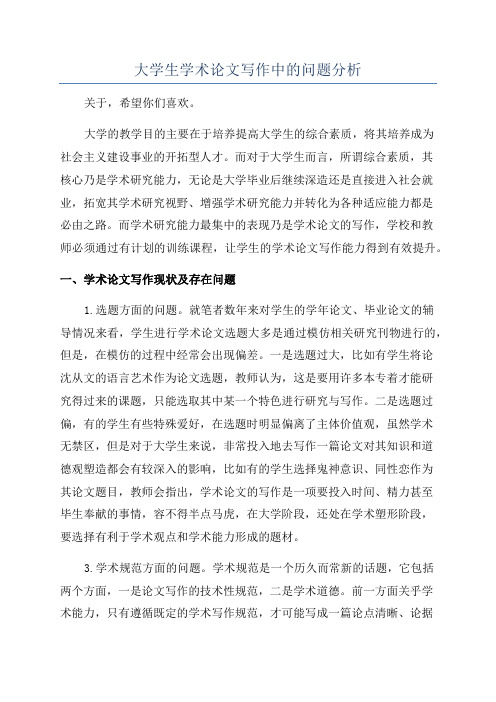
大学生学术论文写作中的问题分析关于,希望你们喜欢。
大学的教学目的主要在于培养提高大学生的综合素质,将其培养成为社会主义建设事业的开拓型人才。
而对于大学生而言,所谓综合素质,其核心乃是学术研究能力,无论是大学毕业后继续深造还是直接进入社会就业,拓宽其学术研究视野、增强学术研究能力并转化为各种适应能力都是必由之路。
而学术研究能力最集中的表现乃是学术论文的写作,学校和教师必须通过有计划的训练课程,让学生的学术论文写作能力得到有效提升。
一、学术论文写作现状及存在问题1.选题方面的问题。
就笔者数年来对学生的学年论文、毕业论文的辅导情况来看,学生进行学术论文选题大多是通过模仿相关研究刊物进行的,但是,在模仿的过程中经常会出现偏差。
一是选题过大,比如有学生将论沈从文的语言艺术作为论文选题,教师认为,这是要用许多本专着才能研究得过来的课题,只能选取其中某一个特色进行研究与写作。
二是选题过偏,有的学生有些特殊爱好,在选题时明显偏离了主体价值观,虽然学术无禁区,但是对于大学生来说,非常投入地去写作一篇论文对其知识和道德观塑造都会有较深入的影响,比如有的学生选择鬼神意识、同性恋作为其论文题目,教师会指出,学术论文的写作是一项要投入时间、精力甚至毕生奉献的事情,容不得半点马虎,在大学阶段,还处在学术塑形阶段,要选择有利于学术观点和学术能力形成的题材。
3.学术规范方面的问题。
学术规范是一个历久而常新的话题,它包括两个方面,一是论文写作的技术性规范,二是学术道德。
前一方面关乎学术能力,只有遵循既定的学术写作规范,才可能写成一篇论点清晰、论据明确、论证有理的文章。
在笔者所辅导的大学生中,曾经出现一种论调,即强调所谓思想,认为有观点有想法的文章,怎么写都行,结果写出来的文章东拉西扯,根本不成篇章。
而实际上一篇论文的各个部分都有其规范,比如摘要,要讲明研究的目的、方法、过程及结论等[2],但学生往往要经过多次重写才能基本达标。
就学术道德而言,从20世纪90年代开始,相继有许多学者学术论文造假被披露出来,其中甚至不乏知名学者,这种现象一方面反映出学术道德的现状不容乐观,另一方面也给年轻学生以极坏的影响和示范作用。
论文中表达学术观点的技巧与原则解析
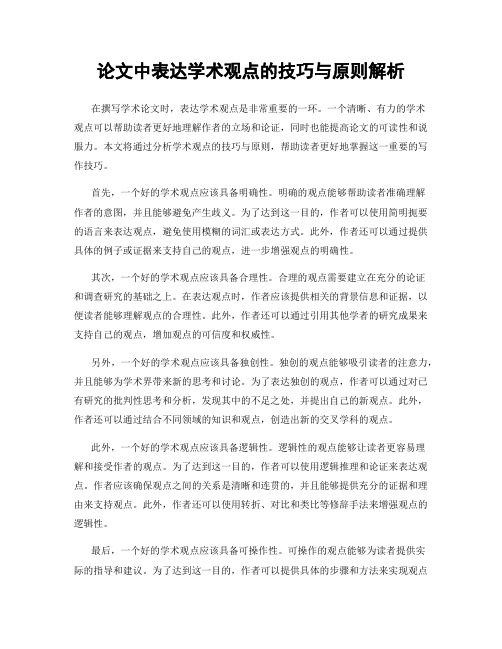
论文中表达学术观点的技巧与原则解析在撰写学术论文时,表达学术观点是非常重要的一环。
一个清晰、有力的学术观点可以帮助读者更好地理解作者的立场和论证,同时也能提高论文的可读性和说服力。
本文将通过分析学术观点的技巧与原则,帮助读者更好地掌握这一重要的写作技巧。
首先,一个好的学术观点应该具备明确性。
明确的观点能够帮助读者准确理解作者的意图,并且能够避免产生歧义。
为了达到这一目的,作者可以使用简明扼要的语言来表达观点,避免使用模糊的词汇或表达方式。
此外,作者还可以通过提供具体的例子或证据来支持自己的观点,进一步增强观点的明确性。
其次,一个好的学术观点应该具备合理性。
合理的观点需要建立在充分的论证和调查研究的基础之上。
在表达观点时,作者应该提供相关的背景信息和证据,以便读者能够理解观点的合理性。
此外,作者还可以通过引用其他学者的研究成果来支持自己的观点,增加观点的可信度和权威性。
另外,一个好的学术观点应该具备独创性。
独创的观点能够吸引读者的注意力,并且能够为学术界带来新的思考和讨论。
为了表达独创的观点,作者可以通过对已有研究的批判性思考和分析,发现其中的不足之处,并提出自己的新观点。
此外,作者还可以通过结合不同领域的知识和观点,创造出新的交叉学科的观点。
此外,一个好的学术观点应该具备逻辑性。
逻辑性的观点能够让读者更容易理解和接受作者的观点。
为了达到这一目的,作者可以使用逻辑推理和论证来表达观点。
作者应该确保观点之间的关系是清晰和连贯的,并且能够提供充分的证据和理由来支持观点。
此外,作者还可以使用转折、对比和类比等修辞手法来增强观点的逻辑性。
最后,一个好的学术观点应该具备可操作性。
可操作的观点能够为读者提供实际的指导和建议。
为了达到这一目的,作者可以提供具体的步骤和方法来实现观点所提出的目标。
此外,作者还可以通过提供实际的案例和应用场景来说明观点的可操作性。
综上所述,表达学术观点是学术论文写作中的重要一环。
一个清晰、有力、明确、合理、独创、逻辑和可操作的观点能够提高论文的可读性和说服力。
论文结构解析每个部分的重要性和写作要点
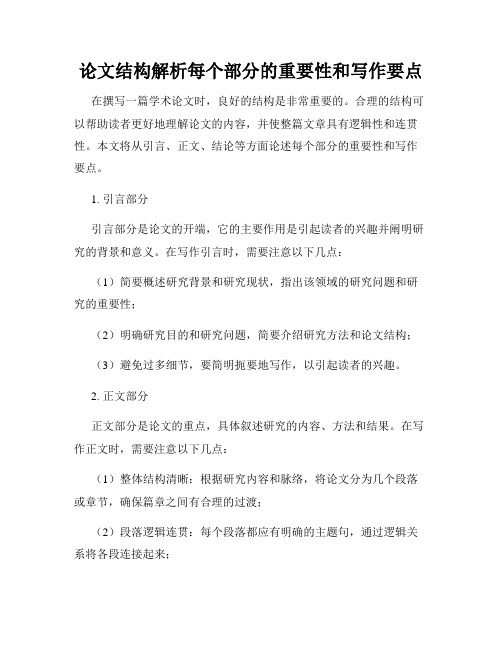
论文结构解析每个部分的重要性和写作要点在撰写一篇学术论文时,良好的结构是非常重要的。
合理的结构可以帮助读者更好地理解论文的内容,并使整篇文章具有逻辑性和连贯性。
本文将从引言、正文、结论等方面论述每个部分的重要性和写作要点。
1. 引言部分引言部分是论文的开端,它的主要作用是引起读者的兴趣并阐明研究的背景和意义。
在写作引言时,需要注意以下几点:(1)简要概述研究背景和研究现状,指出该领域的研究问题和研究的重要性;(2)明确研究目的和研究问题,简要介绍研究方法和论文结构;(3)避免过多细节,要简明扼要地写作,以引起读者的兴趣。
2. 正文部分正文部分是论文的重点,具体叙述研究的内容、方法和结果。
在写作正文时,需要注意以下几点:(1)整体结构清晰:根据研究内容和脉络,将论文分为几个段落或章节,确保篇章之间有合理的过渡;(2)段落逻辑连贯:每个段落都应有明确的主题句,通过逻辑关系将各段连接起来;(3)提供充分的证据和数据支持:要用科学、准确的数据和实验证据来支撑自己的观点和结论;(4)细节和方式的准确描述:对于提出的概念、方法和步骤等,要确切地描写,避免模糊不清;(5)行文流畅:语句通顺,注意使用恰当的过渡词和连接词,使整个文章条理清晰、流畅易读。
3. 结论部分结论部分是整篇论文的总结和归纳,目的是回答研究问题,总结研究的结果和贡献。
在写作结论时,需要注意以下几点:(1)简明扼要地回答研究问题:用简短、明确的语句回顾研究的目标,并给出明确的回答;(2)总结研究发现和结果:对研究的主要发现进行总结和归纳,突出研究的创新点和贡献;(3)分析研究的局限性和展望未来的研究方向:对研究中存在的局限性进行客观分析,并提出未来的研究方向和建议。
综上所述,良好的论文结构是一篇优秀论文的基础。
引言部分可以吸引读者的注意力,正文部分需要具有逻辑性和连贯性,结论部分则总结研究的结果和对未来研究的展望。
在写作过程中,需要注意结构的清晰性、段落的连贯性、数据和实验的支撑,以及语句的流畅性。
研究生撰写学术论文存在问题的原因分析
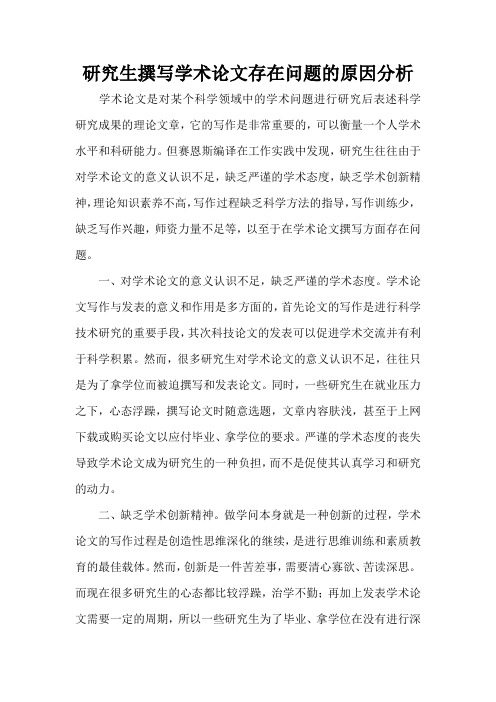
研究生撰写学术论文存在问题的原因分析学术论文是对某个科学领域中的学术问题进行研究后表述科学研究成果的理论文章,它的写作是非常重要的,可以衡量一个人学术水平和科研能力。
但赛恩斯编译在工作实践中发现,研究生往往由于对学术论文的意义认识不足,缺乏严谨的学术态度,缺乏学术创新精神,理论知识素养不高,写作过程缺乏科学方法的指导,写作训练少,缺乏写作兴趣,师资力量不足等,以至于在学术论文撰写方面存在问题。
一、对学术论文的意义认识不足,缺乏严谨的学术态度。
学术论文写作与发表的意义和作用是多方面的,首先论文的写作是进行科学技术研究的重要手段,其次科技论文的发表可以促进学术交流并有利于科学积累。
然而,很多研究生对学术论文的意义认识不足,往往只是为了拿学位而被迫撰写和发表论文。
同时,一些研究生在就业压力之下,心态浮躁,撰写论文时随意选题,文章内容肤浅,甚至于上网下载或购买论文以应付毕业、拿学位的要求。
严谨的学术态度的丧失导致学术论文成为研究生的一种负担,而不是促使其认真学习和研究的动力。
二、缺乏学术创新精神。
做学问本身就是一种创新的过程,学术论文的写作过程是创造性思维深化的继续,是进行思维训练和素质教育的最佳载体。
然而,创新是一件苦差事,需要清心寡欲、苦读深思。
而现在很多研究生的心态都比较浮躁,治学不勤;再加上发表学术论文需要一定的周期,所以一些研究生为了毕业、拿学位在没有进行深入研究的情况下就撰写学术论文,从而导致所发表的论文比较肤浅、创新性不强、学术造诣不高。
三、理论知识素养不高。
一般来说,好的学术论文不仅要选题新颖、有价值,要有独创性的观点,而且要有科学的论据来支持学术观点。
要使学术论文达到这些要求,研究生必须要有较好的理论知识素养。
在研究生阶段,大部分学生都是刚刚涉足自己所研究的领域,往往缺乏相关研究方向的知识积累,理论基础不牢靠。
这不仅会导致研究生在实际工作中走很多弯路,浪费实验资源和宝贵的时间,也会使他们的学术论文存在很多漏洞、缺乏说服力。
论文写作中的学术论文的特点

论文写作中的学术论文的特点学术论文是学术界常用的一种学术交流方式,它具有一些独特的特点,本文将从文体、结构、语言以及引用等方面分析论文写作中学术论文的特点。
一、文体特点学术论文具有正式、严谨的文体特点。
论文中需要使用第三人称,避免使用第一人称,以保持客观性。
同时,学术论文需要使用规范的学术语言,以确保准确性和权威性。
此外,论文中使用的词汇应当精确、准确,避免使用模糊、含糊不清的词语。
二、结构特点学术论文通常包含引言、文献综述、研究方法、结果与讨论以及结论等部分。
引言部分主要包括研究背景、研究目的和研究意义等内容,用于引起读者的兴趣并明确研究要点。
文献综述用于回顾相关研究并说明研究的创新点。
研究方法部分详细描述了研究设计、实验过程以及数据分析方法,以保证研究可复制。
结果与讨论部分用于呈现研究结果并解释研究发现。
结论部分总结研究结果,提出建议或探讨相关领域的未来研究方向。
三、语言特点学术论文需要使用正式、准确的语言来表达,避免使用口语化、俚语和不恰当的词汇。
论文中的句子结构应当简洁明了,清晰易懂,让读者能够直观地理解论文的内容。
同时,学术论文中还需要使用科技术语和专业名词,以确保学术性和专业性。
四、引用特点学术论文中需要引用其他学者的研究成果,以支持观点和加强论证。
引用需要按照规范的引用格式进行,例如APA、MLA等。
引用时需要确保准确无误,且引述内容应当和原文完全一致,不可篡改原意。
同时,需要在论文的参考文献列表中列出所有被引用的文献,以便读者查证。
综上所述,学术论文在论文写作中具有独特的特点,包括正式严谨的文体、明确的结构、准确的语言和规范的引用。
只有熟练掌握这些特点,并在写作中恰当运用,才能撰写出高质量、有学术价值的学术论文。
- 1、下载文档前请自行甄别文档内容的完整性,平台不提供额外的编辑、内容补充、找答案等附加服务。
- 2、"仅部分预览"的文档,不可在线预览部分如存在完整性等问题,可反馈申请退款(可完整预览的文档不适用该条件!)。
- 3、如文档侵犯您的权益,请联系客服反馈,我们会尽快为您处理(人工客服工作时间:9:00-18:30)。
《学术论文写作》课程论文题目The preparation of TiO2 aerogel byambient pressure drying and its performance ofphotocatalytic degradation of oily wastewater学生姓名学号教学院系研究生学院专业年级2013级材料化学工程指导教师职称副教授单位辅导教师职称单位材料科学与工程学院完成日期2013 年12 月 1 日摘要以钛酸四丁酯(TBT)为原料, 利用溶胶–凝胶法、小孔干燥和老化液浸泡工艺在常压下制备出了完整、无开裂的TiO2 气凝胶块体. 研究了小孔干燥和老化液浸泡技术对常压制备TiO2 气凝胶的影响, 研究结果表明: 小孔干燥能够降低TiO2 醇凝胶干燥过程中所受的不均匀收缩应力, 而TBT 醇溶液和TEOS 醇溶液浸泡处理, 能够增强凝胶的骨架强度, 有助于减轻凝胶在干燥过程中的收缩和开裂, 制备出完整的高性能TiO2 气凝胶块体. 基于小孔干燥和TEOS 乙醇溶液浸泡老化处理, 制备得到的高性能完整TiO2 气凝胶块体, 其密度为0.184 g/cm3, 比表面积达389.5 m2/g. 用高温煅烧后的锐钛矿相TiO2 气凝胶催化降解渤海原油污水模拟溶液, 在TiO2 气凝胶加入量为 400 mg/L 的情况下, 90 min 内对渤海原油污水的去除率最高可达91%.关键词:TiO2 气凝胶; 常压; 小孔干燥; 老化液; 光催化; 原油降解AbstractThe monolithic TiO2 aerogel was sucessfully synthesized at ambient pressure throughtechnique with TBT as the raw material and its photocatalyst property forwas investigated .During the ambient drying process, aging liquor and pinhole drying technology were found to be critical to the properties of TiO2 aerogels.in the drying process and the TEOS-Ethanol or TBT-Ethanol solution as the liquor for TiO2 wet-gel could enhance the strength of TiO2 gel skeleton .these effects, and the high-performance TiO2 aerogel monolith was eventually achieved. The most integrated TiO2 aerogel block exhibited low density (0.184 g/cm3) and high specific surface area (389.5 m2/g). By calcinations at high temperature, the TiO2changed from amorphous to anatase structure. The photocatalytic properties of heat-treated TiO2 aerogels were investigated via aqueous emulsion of crude oil in the Bohai Sea. The results of experiments showed that the catalytic degradation rate was up to 91% withaddition of TiO2 aerogel of 400 mg/L.Key words: crude oil degradationContents摘要 (2)Abstract (3)1. Introduction (5)2. Literature review (6)3.Methodology (6)4. Result and Discussion (8)5. Conclusion (15)Reference (16)1.Introductionthe development of modern industry, society and economy,’the demand for energy is growing, the oil exploration, transportation and refining process generated a lot of oily wastewater, causing serious a serious impact on the environment .To make a effective treatment of oily wastewater has become an urgent need to solve the environmental problems.The traditional youngest segment ( ramp degreasing, plus flotation select and walnut shell filter oil ) and other physical treatment , although ,can remove a lot of oil in oily water , but the treated sewage is still a high oil content. What is more, the traditional processing techniques , stay a long time , large equipment volume , large dependence on the demulsifier ,is not suitable for the development of marginal oil fields as needed. Since 1972,Fujishima and Honda et al [1] found that TiO 2 surface water by radiation can continued oxidation-reduction reaction, The photocatalytic reaction based bandgap semiconductor materials has been more widely appreciated by people. Because of the high photocatalytic efficiency , non-toxic , non-polluting ,low price and other features,in recent years, the useing of nano-TiO2 to make a photocatalytic degradation of various organic and inorganic pollutants for environmental pollution, aroused great interest of researchers [4-5] . Since 2002 Ziolli et al [6 ] reported a nano TiO2 photocatalytic degradation of the performance of the Brazilian oil sewage , subsequently many scholars [7-8]studied experimentally,they found that nano-TiO2 has a very excellent photocatalytic degradation performance to the oily wastewater : speed degradation , high degradation rate , low energy consumption , mild reaction conditions , simple operation , wide application, no secondary pollution .But the nano- TiO2 is difficult to be recycled , difficult to promote practical application in industry.For this reason, in recent years many people carried out a load TiO 2 and aphotocatalytic TiO 2 films research [ 8-9 ] , These methods can solve the problem of recovery of the TiO 2, but reduces the effective surface area of TiO2, thereby reducing the photocatalytic efficiency.2.Literature reviewNano- TiO2 aerogel is a porous material ,not only has the independent features of nano TiO2 nanoparticles but also has ultra-high surface area ,and it can be prepared in a complete block structure, which can be solved the problem of difficult to recover when used as a catalyst [ 10 ] , but the traditional TiO2 aerogel were prepared by supercritical drying process , which is high production cost , poor security, and difficult industrial production .[ 11-12 ] .In recent years , solvent replacement ,surfacemodification, technology made a breakthrough [ 13-14 ] , so that researchersexplore the ambient pressure drying for preparing SiO2 aerogel [ 15-16 ] .the reason that the network skeleton of TiO2is weaker than the SiO2. In addition TiO2 aerogel Shrinked and cracked serious , it has been difficult to prepare complete at atmospheric pressure. This work treated TBT as titanium source , based on the sol -with a dry hole and the old of liquid immersion techniqueat atmospheric pressure drying complete no cracking of TiO2 put it to thecrude sewage, and achieved good results.3.1 Preparation of TiO2 aerogels5 mL of tetrabutyltitanate (TBT, AR, Beijing Chemical test Agent Factory) was dissolved in 15 mL of anhydrous ethanol (AR, West Long Chemical Reagent),Then added 0.5 mL of glacial acetic acid, magnetic stirring to form solution A. 2 mL of deionized water was added 10 mL of anhydrous ethanol, was stirred to form solution B . Then B solution was added dropwise to a state of stirring solution A. After A was formed sol, add 2 mL formamide (AR, of West Long Learn Reagent Factory) as a dry chemical control agents. After continue stirring for 3 min, injected into the sol in a cylindrical polypropylene molds, and the mold was sealed with plastic wrap. After the rest period of time at room temperature, then we can get the milky TiO2 alcohol gel.Place gel TiO2 alcohol at room temperature for 1 day, put it into the anhydrouswere then immersed in absolute ethanol, tetrabutyl titanate Ester (TBT) solution of alcohol (ethanol and the volume ratio of 10:1 TBT),tetraethoxysilane (TEOS)in an alcohol solution (by volume of ethanol and TEOS 10:1), and in an environment of 50 ℃soaking 3 d, more daily for once soaked solution gel wassoaked after treatment with anhydrous alcohol washed three times, each time to soak at least 24 h at 50 ℃ environment, soak the gel in a solution to the remaining clean. After washing TiO2alcohol gel placed in an open container or hole polypropylene (container c over open a φ1 ~ 2 mm hole) and then turn on the TiO2 alcogel room temperature, 40 ℃, 50 ℃, 60 ℃, 70 ℃, 80 ℃ under various drying 2 d, Then we can get dried TiO2 airgel blocks.3.2 Photocatalytic TiO2 airgel performance testSodium naphthenate as emulsifier, the Bohai oil (heavy oil) emulsion to 100 mg / L of oily wastewater simulation solution each time taking 0.16 g calcined after crystallization firing TiO2 airgel was added to a mixture of 400 mL water,and kept stirred using a stirrer while open excitation light source (a100 W high-pressure mercury lamp and three 8 W UV lamp (254 nm)).Every so often take a certain volume of the mixture, still in the dark put 2 h later, supernatant was extracted with an equal volume of chloroform its in oil, and then centrifuged at 2500 r / min speed of from Heart 15 min, supernatant using UV-2802PC UV - can see spectrophotometer test solution concentration of crude oil, and then according to the formula as follow can be calculated at any time illumination of the Bohai oil TiO2 aerogels The degradation rate.Ct/Co-1%100/Ct-Co%=⨯=Co)(ηIn the formula, η% said oil degradation rate at time t, C0 is mixed with water the concentration of a mixed solution of the initial time, Ct is adding TiO2 aerogels, open concentration at time t after the mixture of oil and water sources.4.Result and Discussion4.1 Effect of atmospheric holes dried preparation of TiO2 aerogelsFig.1 is a sample photograp of which were dried in an ordinary open container and container holes TiO2 gel. From Fig.1,in general open container the drying TiO2 gel broken into many small pieces, shrunk serious; in the small port container,the drying TiO2 gel looked more complete,only in the middle of the had cracks, and the Shrinkage was l ess than the former.Fig.1 Photographs of TiO2 aerogel dryed at ambient pressure (a) Open container; (b) Pinhole containerCompared with formerstudythe two kinds of TiO2 gel which achieved in diffierent conditions. From the data of the table , compared with an open container the aerogels obtained inholes drying method having a lower density and higher specific surface area (167.5 m2 / g). The results indicats that the holes drying method has a good effect to prevent the gel from Shrinkage and cracking. This is mainly due to the drying rate of the gel and the partial pressure of the ethanol vapor. In an open container , the partial pressure of the ethanol in the container was the same with the environment, which was much lower than ethanol saturated vapor pressure , so the evaporation rate of ethanol is quickly, and the skeleton structure of alcohol gel is exposed to the large instantaneous stress. If the skeleton structure was uneven, the gel would be subject to greater uneven stress and then crack; but in the hole container, for the ethanol molecules evaporated from alcogel cannot spread to the external environment soon, the ethanol steam partial pressure in the container gets closer and closer to the saturated vapor pressure along with the evaporation of fluid ethanol in the gel pores. Thus the evaporation speed of the ethanol and drying speed of alcogel were reduced, which decreased the gel contraction and lowered the possibility of cracking, because the instantaneous compressive stress of the gel network skeleton also has been reduced in the whole drying process of alcogel.4.2 The function of the aging soaking to the atmospheric drying TiO2 aerogelsThe Fig.2 are the TiO2 gels used ethanol, TBT / ethanol solution, TEOS / ethanol solution as aging conservation soaking respectively, and at hole pressure drying. In pure ethanol solution, the TiO2 is translucentthe; and after soaking dried in the TBT and TEOS alcohol, the TiO2 aerogel is pale yellow and completely opaque. What is more, the TiO2 aerogel soaking dried in TBT / ethanol solution cracked into two parts along the center of the sample, and the TiO2 which was soakingdried in theTEOS/ethanol had a perfect appearance and no cracks.Fig.2 Photographs of TiO2 aerogel aged in different liquors (a) Ethanol; (b) TBT-Ethanol solution;(c) TEOS-EthanolTable 2 lists the different aging immersion liquid was prepared TiO2 physical performance parameters of airgel, seen from the data in the table, after TBT after the ethanol solution and soaking TEOS ethanol solution, TiO2 alcohol condensate glue drying shrinkage than pure ethanol produced by soaking samples significantly reduced, airgel prepared by soaking only significantly lower than the density of pure ethanol after drying the airgel samples, the specific surface area is soaked in pure ethanol a substantial increase in the airgel sample, which shows that TBT ethanol solution and TEOS solution in ethanol solution as aging, can be significantly reduced wet TiO2 gel contraction in atmospheric drying process, effectively preventing alcohol gel cracking during the drying process, especially upon aging as TEOS conservation ethanol solution was prepared to give a complete, non-cracking of theprepared TiO2 the body, the density of only 0.184 g/cm3, a specific surface area of 389.5 m2 / g. Such as density and Kucheyev the airgel blocks [17] using CO2 super- TiO2 critical density complete the drying process of the preparation of airgel blocks similar (0.18 g/cm3), the specific surface area above the supercritical drying process technology the specific surface area of aerogels prepared (290 m2 / g).TEOS alcohol solution and TBT alcohol solution as a reason for aging solution TiO2 backbone can improve the strength of the gel , the gel is due to TiO2 porous network node consists of a tiny skeleton of TiO2 particles composed of isomers , between colloidal particles by Ti-O-Ti bonds, hydrogen bonds and van der wales bonded together , the pores in the gel with a small amount of residual water molecules on the surface of colloidal particles and pore walls , then there are a lot of the Ti-OH group when TiO2 gel was immersed in an alcohol solution of TBT TEOS or alcoholic solution , and the solution of TEOS molecules and TBT molecules will diffuse into the pores of the gel , the residual water molecules across hydrolysis reaction of formula (2) or ( 3 ) shown in hydrolysis reaction intermediate the product TiO (OH) 2 or SiO (OH) 2 addition to the self-condensation reaction product occurs a new SiO2 colloid or TiO2 particles filled in the pores of the gel or the network skeleton, skeleton structure of the gel network play support and enhance external effect, but also the surface of the colloidal particles may be Ti-OH group occurs ( 5) condensation reaction represented by the formula ( 4 ) and , between the gel particles generated in the new the Ti-O-Ti bond or Si-O-Ti bond , the TiO2 particles with gel Ti-O-Ti bond or Si-O-Ti bond together , because the Ti-O-Ti bond and Si-O-Ti bond has a strong binding force , but also on TiO2 gel network played a skeleton network enhancement .(2)(3)(4)(5)Figure 3 is a different aging after soaking liquid preparation obtained TiO2 FT-IR spectra of the airgel . Ethanol to pure alcohol and TBT aging the liquid immersion liquid was prepared as a sample , the two -phase IR spectrum recently, a strong absorption at 480 to 533 cm-1peak is near the Ti-O bond stretching vibration absorption, is characteristic absorption peak of TiO2 absorption at 1035 cm-1 Closing peak is C-OH stretching vibration absorption , 1407 cm-1 absorption at Mainly closed by bending carboxyl (-COOH) of the C-O stretching and -OH 1581 cm-1 (1545 cm-1) to absorb vibration caused mainly at the from N-H bending vibration absorption and C-N bond stretching vibration absorption stack plus , these N-H bond , C-N bond , carboxyl groups mainly from adsorbed on the pore walls of the airgel formamide , acetic acid, other organic stars promoter, the absorption peak at 2362 cm-1 was adsorbed TiO2 airgel C-O deformation vibration of the walls of a small amount of mesoporous CO2 molecules , 3165 ( 3185 ) ~ 3400 cm-1 broad absorption peak at airgel table symmetric and antisymmetric adsorbed surface hydroxyl group or water molecules in the O-H bond stretch vibration absorbingreduction [ 18 ]. Immersion aging alcohol solution was prepared as in TBT Samples in 2926 and 2957 cm-1 and two peaks , the major from the C-H bond in the residual organic molecules -CH2- groups of stretching vibration absorption and -CH3 stretching groups in the C-H bond absorption.Fig. 3 FT-IR spectra of TiO2 aerogel aged in different liquors (a) Pure Ethanol; (b) TBT-Ethanol;(c) TEOS-Ethanol4.3 Thermal stability of the atmospheric drying TiO2 aerogelsThe ethanol solution , TBT alcohol solution , TEOS solution immersion of the alcohol TiO2 aerogels discharge processing in a muffle furnace ,respectively, at 480℃, under calcined at 600 ℃ 4 h, after calcination , all three airgel samples remain block Figure 4 is an XRD pattern of the three samples before and after calcination For TBT pure ethanol alcohol solution and soaked samples after 480 ℃ calcined after burning, the sample is completely transformed into the anatase phase , after calcination at 600℃ , a clear diffraction peak of the rutile phase in the XRD pattern shows someTo change rutile TiO2 . TEOS alcohol solution soak for at reasonable sample after 480℃ calcination , will remain the same for the amorphous phase ,appear in the XRD pattern of anatase samples calcined at 600 ℃diffraction peaks , but not rutile production. Thus , TEOS dissolved prepared by soaking liquid phase transition temperature of TiO2 aerogels TBT than pure ethanol alcohol solution and soakingplace to soak aging preparation of sample processing phase transition temperature is high, which is due to the TEOS solution as the aging process of soaking TiO2 gel , forming a large number of Si-O-Ti bond, TiO2 phase change can be suppressed to improve the gas TiO2 Gel thermal stability [ 15 ] .Fig. 4 XRD patterns of TiO2 aerogel calcined at different temperatures TiO2 aerogel aged in (a) ethanol; (b) TBT-ethanol; (c) TEOS-ethanol4.4 The photocatalytic properties of different aging soaking liquid preparation ofTiO2 aerogesTreat the calcined anatase phase TiO2 aerogels as a photocatalyst , test its photocatalytic degradation of performance of the Bohai Sea crude sewage. Figure 5 isthe photocatalytic degradation curves for bohai oil products by TiO2 aerogels prepared in different aging soaking ( The relative concentration of crude oil (C/C0)% -. illumination time curve ). As can be seen from figure , when the gel as a photocatalyst to decompose Bohai oil sewage, at the beginning of the bright lights, the concentration of crude oil in the mixture solution declined quickly, then gradually slows. Compared the three different degradation curves of the TiO2 aerogels, the degradation ability and the rate is increaing from alcohol solution to TEOS alcohol/solution. The main reason for this phenomenon is the difference of the surface area. As we know, the process of organic degradation contained the adsorption of the organic and the oxidation of the organic by the electron - hole pairs producted UV excitation. So the larger the surface area of the TiO2 aerogels the stronger adsorption capacity for organic molecules, as a result, the higher catalytic efficiency and the faster degradation rate. The table 3 lists the different surface area and catalytic degradation rate at 90min which was prepared by different aging soaking liquid and calcined in a high temperature. Among them, the sample which was prepared by the Traditional wordTEOS solution and calcined into anatase still had a high surfacethe area up to 210.4m 2/g, while the sample prepared by TBT and ethanol only had 49.8m 2/g and 15.8m 2/g respectively. The corresponding degradation rate of 90 min was 91 %, 87 %, 79 % respectively. This shows that the gegradation efficiency of the Bohai Oil has a certain relationship to the surface area.Fig. 5 Photocatalytic degradation curve of oily wastewater5. Conclusion 1 ) Firstly , a small hole drying method can reduce the sample suffers a uneven shrinkage stress, shrinkage and cracking of the TiO2 aerogel. The process helps to achieve perfect aerogel blocks.2 ) In addition,t he using of TBT and TEOS solution as a aging solution can enhance the skeleton strength of the TiO 2 glue , reduce the shrinkage and cracking of the TiO2 aerogel during the drying process. As a result,we can achieve a Complete block with high surface area, especially the TEOS.PresenttenseTransitionalwords3 ) Moreover, using TEOS alcohol solution as a aging solution, because of theforming of the Si-O-Ti bond, it can prevent the phase transition and improve thethermal stability of TiO2 aerogels.4 ) Finally, the TiO2 aerogels after calcination into anatase phase by high temperature has a good photocatalytic degradation. The degradation rate and the degradation speed have a great reletionship to the surface area.AcknowledgementThe authors are grateful to National Natural Science Foundation of China for nancial support .Reference[1] Fujishima A, Honda K. Electrochemical photolysis of water at a semiconductorelectrode. Nature, 1972, 238: 37–38.[2] Chuangchote S, Jitputti J, Sagawa T, et al. Photocatalytic Activity for HydrogenEvolution of Electrospun TiO2 Nanofibers. Applied Materials andInterfaces,2009, 1(5): 1140–1143.[3] Guo Peng, Liu Chun-Yan, Gao Min, et al. Effect of ZSM-5 crystal size onproperties of supported TiO2 photocatalyst. Chinese Journal of Catalysis, 2010, 31(5): 573–578.[4] Kim M I, Park D W, Park S W, et al. Selective oxidation of hydrogen sulfidecontaining excess water and ammonia over vanadia–titania aerogel catalysts.Catalysis Today, 2006, 111(3/4): 212–216.[5] Jing Wen-Heng, Wang Wei-Gang, Xing Wei-Hong. Preparation and photocatalyticactivity of macro-mesoporous N-doped TiO2. Chinese Journal of Catalysis, 2009, 30(5): 426–432.[6] Ziolli R L, Jardim W F. Photocatalytic decompsition of seawater-soluble crude oilfractions using high surface areacolloid nanoparticles of TiO2. Journal of Photochemistry and Photobiology a-Chemistry, 2002, 147(3): 205–212.[7] Hsu Y Y, Hsiung T L, Wang H P, et al. Photocatalytic degradation of spill oils onTiO2 nanotube thin films. Marine Pollution Bulletin, 2008, 57(6-12): 873–876.[8] Liao Zhen-Hua, Chen Jian-Jun, Yao Ke-Fu, et al. Preparation and characterizationof nanometer-sized magnetic photocatalyst TiO2/SiO2/Fe3O4. Journal of Inorganic Materials, 2004, 19(4): 749–754.[9] Addamo M, Augugliaro V, Paola A D, et al. Photocatalytic thin films of TiO2formed by a Sol–Gel process using titanium tetraisopropoxide as the precursor.Thin Solid Films, 2008, 516(12):3802–3807.[10] Akpan U G, Hameed B H. The advancements in Sol–Gel method of doped-TiO2photocatalysts. Applied Catalysis A: General., 2010, 375(1): 1–11.[11] Chen Long-Wu, Gab Li-Hua, Xu Zi-Jie. Preparation and characterization ofmonolithic TiO2 aerogels. Chemical Journal of ChineseUniversites,2001,22(11): 1916–1918.[12] Stengl V, Bakardjieva S, Subr J, et al. Titania aerogel prepared by lowtemperature supercritical drying. Microporous and Mesoporous Materials, 2006, 91(1/2/3): 1–6.[13] Hwang S W, Kim T Y, Hyun S H. Effect of surface modification conditions onthe synthesis of mesoporous crack-free silica aerogel monoliths from waterglass via ambient-drying. Microporous and Mesoporous Materials, 2010, 130(1/2/3): 295–302.[14] Hwang S W, Kim T Y, Hyun S H. Optimization of instantaneous solventexchange/surface modification process for ambient synthesis of monolithic silica aerogels. Journal of Colloid and Interface Science, 2008, 322(1): 224–230.[15] LIU Zhao-Hui, SU Xun-Jia, HOU Gen-Liang. Effects of silicon content onmicrostructure and photocatalytic activity of TiO2/SiO2 composite aerogels.Journal of Inorganic Materials, 2010, 25(9):911–915.[16] Hu Jie-Gang, Chen Qi-Yuan, Li Jie, et al. Preparation of TiO2 aerogels byambient pressure drying. Journal of Inorganic Materials,2009, 24(4): 685–689.[17] Kucheyev S O, Baumann T F, Wang Y M, et al. Synthesis and electronicstructure of low-density monoliths of nanoporous nanocrystalline anatase TiO2.Journal of Electron Spectroscopy and Related Phenomena., 2005, (144–147): 609–612.[18] Cao S L, Yao N, Yeung K L. Synthesis of freestanding silica and titania-silicaaerogels with ordered and disordered mesopores. J. Sol-Gel Sci. Technol., 2008, 46(3): 323–333.[19] Armaroli T, Milella F, Notari B. A spectroscopic study of amorphous andcrystalline, Ti-containing silica and their surface acidity. Chemistry and Materials Science., 2001, 15(1): 63–71.。
